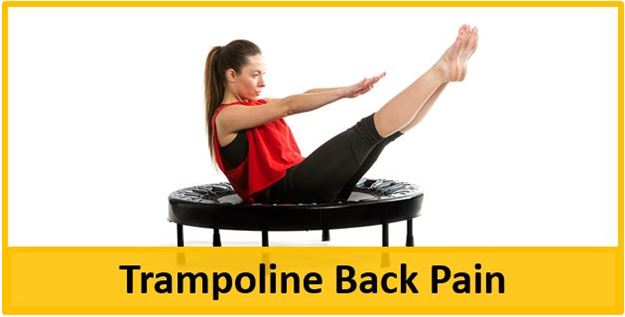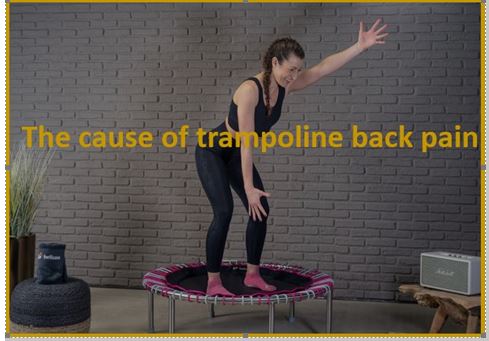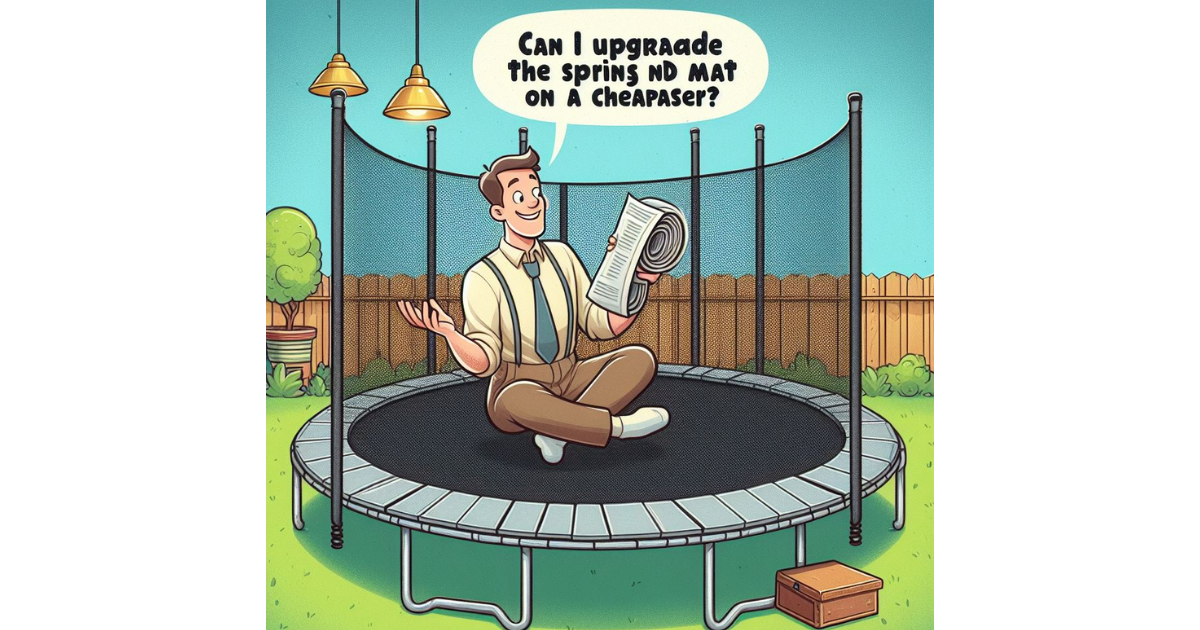Despite trampolining being one of the best forms of exercise for all ages, there are sometimes complaints about trampolines that have to do with back pain. Muscle tension is often the root of back pain or trampoline back pain. These trampolines are the most common cause of back pain since they stretch the muscles too hard or too suddenly.
The problem starts with a poor landing posture, back pain, muscle strain, spinal disc damage, and lateral joint injuries. Individual jumpers can combat this by jumping with their legs instead of their backs.
Back pain is mainly caused by muscle tension when a muscle is stretched too fast or too hard. Poor landing technique can injure the spine, side joints, and muscles. If the jumper wants to avoid this, he should jump with his legs and not his back.
There are three main reasons for this.
- After jumping off the trampoline, most of the people have no idea how to stand up.
- After jumping, they bounce heavily on their front or hind legs as they hit the ground.
- During the jump, they lean forward or backward, and they land on their stomachs.
Learn proper landing techniques before jumping on a trampoline to avoid moderate back pain.
Trampoline back pain
Trampoline back pain often leads to traumatic events, especially for trampoline users. Among the problems, orthopedic doctors and trampoline specialists reported are spinal pain, neck pain, muscle tension, and facial joint injuries.

This group of gymnasts has a lot of trouble jumping unconsciously on a trampoline. There are many other causes as well.
Can trampoline jumping harm your back?
When you jump on a trampoline, your body tightens the lumbar muscles to protect your spine. If you suffer from degenerative disc disease or a herniated disc, muscle tightness can make the situation worse. Therefore, you may find that your back hurts more after trampoline sessions when it feels like you have already done it
On the other hand, Trampolines can alleviate back pain in some situations. In spondylolisthesis (where the spine fails to support itself properly), trampolining can help people. As a result of trampoline activity, some joints and ligaments are strengthened, resulting in better physical shape.
Trampolining benefits both individuals and the environment. However, it can also increase your pain. Therefore, if you have a back problem of any kind, you should consult a doctor.
Trampolining is not an exercise in and of itself, and it is not bad for your back. If done correctly, getting low-impact exercise is an excellent technique.
It is common for back injuries to result from jumping on a trampoline. Jumping on a trampoline may increase your risk of contracting the disease if you already have it. Warming up properly will also prevent you from straining your muscles and injuring yourself. I will talk about it in detail in later section.
Last but not least, you could fall off the trampoline and cause severe damage to your spine. The average person is still unable to afford one.
As a general rule, we strongly recommend protecting yourself from injuries and responding to back pain as soon as possible.
The cause of trampoline back pain
Jumping on the trampoline and being unaware of your jumping posture are the significant causes of back pain.
There are several reasons behind this, and they are outlined below:
- Trampoline users have trouble getting off their feet after jumping off a trampoline.
- They land on their front or hind legs after jumping with a high bounce.
- The jumper falls on their stomach or leans too far forward or backward.

It would be best to learn proper landing techniques before jumping on a trampoline to avoid middle back pain. Once you leave it, you also need to learn how to manage your bounce rate.
Trampolines are known to cause back pain. Trampoline users jump on trampolines without exercising before using them. Nevertheless, sick people should avoid trampolines since they do not always suffer injuries due to their illness.
Trampolines are not recommended for children under six because their bones are weak. When someone jumps into the wrong posture, they may suffer many injuries. Users new to stuns are unlikely to perform them since they are unfamiliar with them. Back pain is the most common complaint among trampoline users. Many trampoline users jump on them without exercising first. As sick people are not always at risk for injuries on trampolines, they should avoid jumping on them when they are ill.
Weak bones make it unsafe for children under six to use the trampoline. A user may suffer an injury of any sort if they make an incorrect currency jump. As new users, users should not attempt stunts, as stunting is not normal.
Possibility of the spinal cord or herniated disc injury while jumping on a trampoline
When you jump on trampoline/rebounder, it is natural to injure your spine. In different types of falls, the extent of wounds may vary, resulting in paralysis, quadriplegia, or even death. Permanent spinal cord damage is also possible.
When someone falls off a trampoline, his spine is injured, but he still feels and moves to some degree. This is called a partial injury. Those who experience a severe spinal cord injury, on the other hand, are unable to move or feel in any way under the damaged area.
There are visible signs of severe spinal cord damage, such as muscle weakness, trouble breathing, and tremors in the arms and legs. When a person falls, they mustn’t move and wait for medical treatment.
It is possible to suffer a spinal cord injury while jumping on a trampoline, but it is infrequent, and if you don’t use the trampoline properly, you may find yourself with such severe pain. Be careful!
Trampolining is not only a fun and recreational sport, but it also helps you uniquely improve your muscles and exercise.
How to find out when you have an injury to your back or upper neck?
A strained muscle or an injured ligament or disc can cause pain in your upper back after jumping on a trampoline.
Here are some signs that you might have an upper back injury:
- Initially, you may experience a burning, scorching sensation in your upper back.
- Later, you may experience severe pain and stiffness in your muscles.
- Your arms and legs may also become weak.
This type of back pain can be relieved with massage, over-the-counter medication, cold, and heat.
What to do if you suffer from lower back pain or Upper Back Pain?
Trampoline users are more likely to suffer from lower back pain. You exercise your back, legs, and pelvic floor muscles on the trampoline. These muscles provide spinal cord protection. A weaker body is more likely to experience lower back pain after jumping on a trampoline.
To protect their spine, they must work harder. As a result, the muscles stiffen, causing fatigue and discomfort. One of the worst outcomes of affecting your body can be damage to your muscles or spinal cord. Therefore, we recommend using a trampoline or rebounder more specifically for easy access.
However, keep in mind that you may have to face more back pain if you are not doing properly.
Upper Back Pain when Jumping on a Trampoline – Reaosns and Solutions
Poor Posture and Technique
Ensure that you’re maintaining proper posture while jumping. Arching your back or hunching forward can strain the upper back. Focus on keeping your back straight and engaging your core.
Lack of Warm-up
Jumping without proper warm-up may contribute to upper back pain. Perform dynamic stretches and gentle exercises to prepare your muscles before engaging in more intense trampoline activities.
Overexertion
If you’re new to trampolining or have recently increased the intensity of your workouts, your upper back may not be accustomed to the strain. Gradually increase the intensity and duration of your trampoline sessions.
Muscle Weakness
Weak upper back muscles can lead to discomfort. Incorporate exercises that target the upper back, shoulders, and neck to strengthen these muscles and provide better support during trampoline activities.
Lower Back Pain when Jumping on a Trampoline – Reaosns and Solutions
Improper Landing Technique
Ensure you’re landing on the trampoline with your knees slightly bent to absorb the impact. Landing with straight legs can transfer excessive force to the lower back, causing pain.
Weak Core Muscles
A lack of core strength can contribute to lower back pain. Incorporate exercises that target the core, such as planks and bridges, to improve stability and support for your lower back.
Excessive Jumping Height
Jumping too high can lead to a hard landing, causing strain on the lower back. Focus on controlled and moderate jumps to reduce the impact on your spine.
Inadequate Warm-up
Like the upper back, a proper warm-up is crucial for the lower back. Include dynamic stretches and light exercises to prepare your lower back muscles for the trampoline workout.
Pre-existing Conditions
If you have existing back issues or injuries, jumping on a trampoline may exacerbate the pain. Consult with a healthcare professional before engaging in trampoline activities, especially if you have a history of back problems.
Tip: You should use Lower Back Pain Relivers while doing any physical tasks including trampoline jumping.
Is trampoline jumping well for back pain?
It is possible to reduce and even eliminate back pain after jumping on a trampoline. Firstly, you should examine your spinal cord for any signs of rotation. Also, determine if your back pain is confined to one side or equally distributed.
Additionally, be sure to indicate where exactly the discomfort is located in your lower, middle, or upper back. The most popular treatment for back pain is taking a long, warm shower. Directly below the painful area, water should fall.
Relaxing muscles and relieving back pain are two of the many benefits of warm water. Exercises such as rehabilitation and stretching can also be done in warm water. If you do not do it properly, it can cause back pain.
After that, you need to do muscle relaxation therapy. Our recommendation is to consult a physician when none of this works, who will be able to prescribe medication or other treatment for you.
How to jump on a trampoline safely and avoid getting hurt
Follow these basic guidelines to prevent injuries and maximize training benefits:
- Wear comfortable sportswear that do not impede your movement when jumping on the trampoline. It is not necessary to wear shoes.
- When separate jumping, follow the proper procedure. Neither your pockets nor your hands contain anything complex or dangerous.
- Get on the trampoline mat in the center.
- You should not jump on the trampoline if you are pregnant or on your period.
- People over the age of six should not jump on the trampoline.
- Take a few minutes to warm up before exercising.
- Don’t jump right into challenging exercises.
- Newcomers need time to relax and recover following a workout.
- Use trampoline safely.
Exercising on your own is not recommended. Under the guidance of a coach who can identify faults and prevent damage, you should learn each jump technique.
How to get rid of center-back pain while trampling?
Lower back pain and tension are joint and can occur at any time. Standing or sitting correctly may be difficult if your back is thrown out. When trampling is always necessary, remember this.
Here are seven tips for preventing back pain and regaining mobility after an accident. Chiropractic or orthopedic care may be necessary if you have chronic back pain.
Put it in a bag
Everyone knows this, yet it is repeated over and over again. A simple dose of icing can work wonders on an inflamed body. If you have a back injury, apply ice several times within the first 24-48 hours to reduce pain and minimize swelling.
Drink more water
Hydrate your spine with water and eat fruit and vegetables that contain water. Dehydrated discs cause the back to become stiff and painful.
Is your body hydrated enough? Monitor your urine color. When the color is a light lemon, you’re doing well.
Keep moving
If you sit for an extended period, keep moving. In contrast, tightening the hips and hamstrings will worsen the condition. For this reason, standing desks are becoming increasingly popular in the workplace. It is always better to walk and move around than to sit still.
Massage Therapy
Massage therapy can help alleviate back pain by removing trigger points and lumps. It’s an excellent preventative measure to relieve tension and discomfort in the lower back, hamstrings, and hips by massaging daily with a tennis ball or foam roller. In addition, this is a much more affordable alternative to traditional massage.
Hip elastic
Human bodies are designed to keep the lower back safe and move the hips freely. Many people rely on the lower back to perform this task, although it is neither mechanical nor emotionally suited. An injury usually results from this. Our workouts include lying down, sitting 90-90, and kneeling/wall hip flexor stretching routines to address this issue.
Use an extra pillow
If you sleep on your back or your side, place an extra cushion between your knees to support your spine and keep you awake. There is little chance of you falling asleep.
Technique
Make sure your back does not round when lifting anything off the floor, that the object is close to you, and keep your legs and hips straight. Do not bend below the waist. Your knees and hips should be bent, and your back should be straight when you begin the exercise.
Related Articles:
- Why Do My Kidneys Hurt on a Trampoline?
- Chest Hurts When Jumping On Trampoline
- Why Does My Neck Hurt After Jumping On A Trampoline?
- Why My Ribs Hurt After Trampoline Jumping?
- Can Jumping on a Trampoline Hurt Your Brain?
FAQs
What does a trampoline do to your spine?
The force of motion will push your spine to the ground after you jump on the trampoline. This movement can alter the spinal cord’s attachment to your body.
The spine is under constant stress, which explains why we experience pain and injuries. A sudden injury to the spinal cord can cause our brain to explode with pain signals that can range from mild to severe.
Jumping or playing on a trampoline can be dangerous, but spinal fractures are often not as severe as they seem.
Why does my back hurt when I jump up and down?
Your spine is put under pressure when you jump up and down. As a consequence of this pressure, muscles become tense, causing pain.
The pain may be caused by a severe medical condition, like spinal stenosis or fractures. The problem can also be caused by irritation in another area out of alignment. If you have concerns about your back, it is essential to discuss them with your doctor.
The spine bends under the weight of your body when you jump up and down, but it returns to its original position afterward. The neck, chest, abdomen, and pelvic muscles work together to maintain this new angle. Spinal rotation is the process of maintaining this new angle.
This occurs because gravity causes them to contract eccentrically when jumping usually.
How often should you rebound while on the trampoline?
It would be best to rebound when you are on your ‘up’ phase. Your springs will be at their lowest point during this time. You start moving back down when you have gotten a sufficient distance between you and the ground.
During your up phase, you should rebound every 2 seconds. If you are at the bottom of your bounce, come back every 3 seconds.
You can bounce higher as the force pushes you upwards by bouncing on a trampoline spring. This upper force pushes the spine into the spring padding when a person bounces on his back, causing back pain and injury.
Bounce as often as you can without feeling any discomfort. Stop immediately if you think you are pushing your body too far.
Who should not use a mini trampoline?
Mini trampolines can be a great idea for some people. It allows them to exercise while increasing their personal space and time. The height of the trampoline is too high for those with osteoporosis or other bone symptoms. A mini trampoline should be purchased with consideration for the buyer’s health.
How do you know if your back pain is muscular?
When you experience tightness and pain in your chest, one of the first symptoms is muscle pain in your back. The pain could make it difficult for you to sleep.
It is common for people to describe back pain as stabbing or sharp. Back pain of this type affects an area of the body, such as the lower back, upper back, or neck. An individual’s back pain typically lasts between three and six months before it disappears on its own.
Muscle injuries have the same symptoms as a sharp stabbing pain that comes and goes, so many people confuse them with recurrent severe lower back pain.
Conclusion
For adults and children alike, trampoline jumping has always been a source of fun and entertainment. Specific movements can also cause Trampoline injuries. The study did not conclude that trampoline jumping is harmful to consumers but is very helpful for all ages.
Trampolines made by various manufacturers claim to be the most popular on the market. Despite this, there is no such thing as the safest trampoline. Therefore, you must be careful not to harm yourself. Back injuries are the most common type of injury. Many of them are minor, but others may prove deadly.
Therefore, while jumping on a trampoline, you need to learn to maintain your movement. Keep a close eye on how your body moves. You will be less likely to get injured if you do so.
Articles You May Like to Read:













